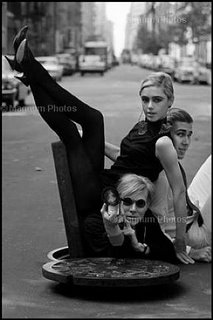
Ok, I know it’s all about Edie right now. From Chloe’s spring 2006 collection to Sienna Miller’s new role, she is the icon du jour. Fashion magazines and their idolaters alike heatedly praise Edie as if she was the patron saint of Pop Art. I’m sorry, I may have been born in the 80s but before Sienna, I never heard of this so-called factory girl. For all I know, she could have been a Guatemalan sweatshop worker pumping out Kathie Lee Gifford parkas for 2 cents a pop.
But who is Edie Sedgwick really? And why is she an icon?
Edith Sedgwick was born in 1943 to a wealthy Santa Barbara rancher and his wife. In her short life, she was an American socialite, model, fashion icon and most famously Pop artist Andy Warhol’s muse and favorite factory girl.

The Factory was Warhol's studio. In an old New York loft building, Warhol and his assistants (“factory girls”) produced artwork by day and threw lavish parties by night. Soon the Factory became the hottest place to be in the 60’s with an eclectic mix of artists, poets, addicts, socialites, and drug dealers. (Think Bungalow 8 on LSD.)
Sedgwick, a Factory regular, also dabbled in drugs including heroin and barbiturates, which ultimately served as her demise in November 1971 when she died from overdose. She was 28. Among her accomplishments, Edie modeled in magazines such as Vogue and Vanity Fair, becoming a symbol of the 60s mod fashion; starred in a number of cult films including, Ciao! Manhattan; and allegedly was the inspiration for many of musician Bob Dylan’s love songs.

Like many fashion personalities, Edie’s glamorous life was just a façade. She suffered from clinical depression and anorexia, which eventually got the best of her. Her sad life was masked by the commercialized beauty of glossy photographs, short films and one dimensional silkscreen prints by Andy Warhol. Perhaps that’s what he found so intriguing. Obsessed with the commercialization of American culture, Warhol most likely found this forged beauty personified in Sedgwick. The plastic beauty that only grazed the surface of Edie became her public identity. Her legacy of mod minis, black tights and super long earrings is all that she leaves behind.
Final Word: Although we may never know the real Edie, we can thank her for her eclectic life, her courage to beat to a different drum and her unique style that inspired an entire movement in art and fashion alike. If that’s not an icon, I don’t know what is.
No comments:
Post a Comment